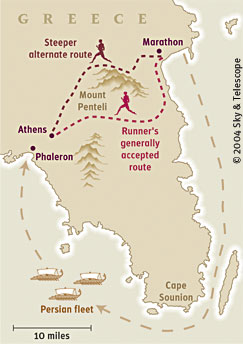***Embargoed Until 2 a.m. EDT, July 19, 2004***
Contact:
Jayme Blaschke
Media Relations and Publications
Texas State University, San Marcos
512-245-2180
[email protected]
| Note to Editors/Producers: This release, which is being simultaneously issued by Sky & Telescope and Texas State University, is accompanied by two publication-quality illustrations; see details below. |
On August 29th a field of runners at the 2004 Summer Olympic Games in Athens, Greece, will retrace one of the most famous runs in history. Half a world away, a team of researchers in Texas is shedding new light on the origins of the legendary race. In "The Moon and the Marathon," appearing in the September 2004 issue of Sky & Telescope magazine, Donald W. Olson, a physics and astronomy professor at Texas State University, and his San Marcos colleagues Russell L. Doescher and Marilynn S. Olson present astronomical evidence that the commonly accepted date of the famous Battle of Marathon and the ensuing run may need to be reconsidered. The legend was born in 490 BC, when a lone runner raced some 26 miles from the battlefield to Athens to bring word of the Greeks' victory over the Persians at Marathon and to warn the city of an impending invasion from the sea by the Persian fleet. His mission accomplished, the runner collapsed and died. This melodramatic death has proved problematic for historians over the centuries. Why would an experienced long-distance runner collapse when thousands of amateur runners successfully compete in marathons worldwide? The answer, according to Donald Olson and his colleagues, lies in the phases of the Moon. "The Greek historian Herodotus provides precise descriptions of the phase of the Moon near the time of the Battle of Marathon," said Donald Olson. "These are the key to dating the battle and the Marathon run using astronomy." When the Athenians first learned of the Persian army's landing at Marathon, city leaders dispatched a messenger to Sparta, 150 miles away, to plead for military aid. The Spartans promised to help, but they explained that because of a religious festival their army could not march before the next full Moon — six days away. Judging that the festival was the Karneia, 19th-century German scholar August Böckh carried out a series of astronomical calculations to determine the date of the Karneian full Moon and determined that the Battle of Marathon took place on September 12th. Böckh relied on a reference from Greek scholar Plutarch that equated the Spartan month of Karneios with Metageitnion, the second month of the Athenian year. "We realized that Böckh's method of dating, using the Athenian calendar, had a serious flaw," Olson said. "The Karneia was a Spartan festival, so the analysis should be done using the Spartan calendar." Although the Spartan and Athenian calendars were similar in that they were both lunisolar — following the lunar cycle, but making adjustments to stay in step with the solar year — they were not identical. The Athenian year began with the first new Moon following the summer solstice, but the Spartan year apparently began with the first new Moon after the fall equinox. Further, in 491-90 BC, 10 new Moons occurred between the fall equinox and summer solstice instead of the normal nine, resulting in the Spartan calendar's running a month ahead of the Athenian. If the Texas State researchers are correct, the Battle of Marathon actually took place on August 12, 490 BC. Previous writers have noted that the average maximum temperature in Athens during September is approximately 83° Fahrenheit. Moving the Marathon date up just one month has a dramatic effect. The average August afternoon temperatures along the marathon route range from 88°F to 91°F, with temperatures as high as 102°F possible near Athens. The astronomical calculation therefore suggests an explanation for the death of the runner: such conditions could lead to heat exhaustion and heat stroke in even a trained athlete. The September 2004 issue of Sky & Telescope will be available on newsstands on August 3rd. Reporters and editors who would like to obtain a PDF of the article "The Moon and the Marathon" before that date should contact Jayme Blaschke at [email protected].
Sky & Telescope is making the following publication-quality illustrations available to the news media. Permission is granted for one-time, nonexclusive use in print and broadcast media, as long as appropriate credits (as noted in each caption) are included. Web publication must include a link to SkyandTelescope.com.

The events of 490 BC took place in the region of Greece called Attica. The Persian fleet sailed from Marathon and around Cape Sounion in an attempt to land at Phaleron, the port of Athens. The route of the herald and the Athenian army between Marathon and Athens is not known. Most scholars advocate the path southeast of Mount Penteli, and this course will be used in the Athens 2004 Olympic Games. A few authors argue that the messenger in 490 BC might have used a shorter but steeper route passing through the hills northwest of Mount Penteli. Click on the image above to download a publication-quality version (115-kilobyte JPEG) by anonymous FTP.
Sky & Telescope illustration by Casey B. Reed.

Herodotus refers to Pheidippides with the Greek word 'hemerodromos,' which means literally 'all-day runner.' This illustration comes from Piers Plowman Histories, Junior Book II, Stories from Greek, Roman, and Old English History (George Philip & Son, 1913). Click on the image above to download a publication-quality version (430-kilobyte JPEG) by anonymous FTP.
Courtesy the collection of Donald W. Olson.
Sky Publishing Corp. was founded in 1941 by Charles A. Federer Jr. and Helen Spence Federer, the original editors of Sky & Telescope magazine. The company's headquarters are in Cambridge, Massachusetts, near the Harvard-Smithsonian Center for Astrophysics. In addition to Sky & Telescope and SkyandTelescope.com, the company publishes Night Sky magazine (a bimonthly for beginners with a Web site at NightSkyMag.com), two annuals (Beautiful Universe and SkyWatch), as well as books, star atlases, posters, prints, globes, and other fine astronomy products.
 1
1
Comments
You must be logged in to post a comment.